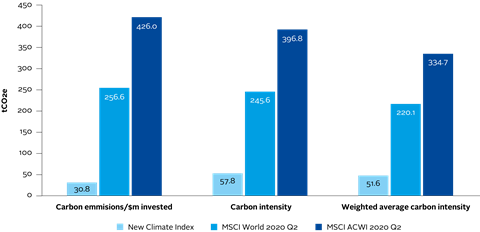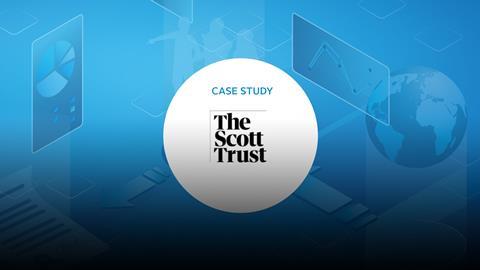Case study by The Scott Trust Limited (Guardian Media Group)
- Signatory type: Asset owner
- Region of operation: UK
- Assets under management: £1 billion
Why ESG plays a vital role in our asset allocation decisions
The Scott Trust is the owner of the Guardian Media Group, which publishes The Guardian newspaper and website. We believe that long-term sustainable returns are dependent on stable, well-functioning and well-governed social, environmental, and economic systems. As such ESG considerations are fully integrated in all our asset allocation decisions.
We believe that the economic materiality of sustainability issues is totally aligned with the fund’s primary duty of generating strong risk-adjusted returns and is in line with our organisational values.
At a total portfolio level, we have made some key asset allocation decisions and targets, described below, and closely tracked progress over time across asset classes.
How setting clear targets helped us integrate ESG into our portfolio
Divest and reinvest: we made a key decision in 2015 to divest entirely from fossil fuels over the medium term and re-invest in solutions for a low-carbon economy. To date we have achieved 95% reduction with immaterial residual positions in the runoff.
Majority of assets with ESG leaders: As we invest sustainably across asset classes, we expect most of our assets over time to be invested with managers that we judge to be very proactive thought leaders on ESG. That means going beyond just policy and process. We have a target of 60% over time and are already at 54%.
Impact investing targets: we also set, and subsequently made more ambitious, asset allocation targets to investments intentionally seeking a positive social and/or environmental impact. We have a target of 10% over time, with current commitments exceeding 6%.
Some key points on this journey:
- Anchor new products across asset classes: Where we found gaps in certain asset classes, we have worked with partners to seed new ESG products. In recent years we have seeded 9 new strategies across multiple asset classes which have gone on to attract over £1.2 billion of investment from other investors.
- Reimagine the role and composition of asset classes: As we embraced ESG in asset allocation, certain asset classes had to be reimagined. For example, we believe investors must reassess the inflation sensitivity of investments, since the drivers of inflation in a more sustainable and more circular economy will diverge from past drivers.
Carbon is unlikely to be a good inflation hedge in a de-carbonising economy, yet it still looms large in many conventional ‘inflation-sensitive’ asset allocations. Here, we avoided traditional natural resources investments and re-allocated to a strategy focussing on sustainable infrastructure, clean power generation, agriculture, and commodities more relevant to a low-carbon future. This offers inflation sensitivity without the stranded asset risk present in conventional energy assets.
Certain diversifying asset classes have less solid ESG credentials and have been reduced as we take a long-term approach to sustainability and risk. That said, we have seeded some ESG innovations in select absolute return funds. - Diverse impact investments: our recent allocations to specialist impact investing funds have included:
- Venture capital with a clear gender lens, backing female-led impactful companies in health, education, and sustainable sectors
- Sustainable private infrastructure spanning energy, water, agriculture, transportation and land
- Greenfield renewable power assets in emerging markets
- Early stage innovations in dementia treatment
- Pollution control and energy efficiency in private equity.
Modelling work has involved tracking reductions in portfolio fossil fuel exposure, carbon emissions and carbon intensity, and measuring increases in allocations to businesses making key social and environmental contributions and those with higher ESG scores. Climate scenario analysis has been used to extrapolate forward on climate alignment.
Example: Designing a climate tracking fund
We feel simple market-cap-weighted benchmarks are poorly aligned with the transition to a low-carbon economy whilst also facing the risk of stranded assets. We therefore changed our core passive equity allocation.
In 2019, wishing to have more material tilts away from high-carbon businesses than existing low-carbon indexes, we anchored and were instrumental in designing a pooled fund tracking the new MSCI World Custom ESG Climate Series A Index. This removes all exposure to fossil fuel producers, and materially reduces exposure to high-carbon emissions. It then positively tilts towards (a) low-carbon solutions (alternative energy, energy efficiency, green building, pollution prevention & sustainable water) and (b) companies showing forward momentum on climate alignment. It also has other ESG and ethical filters, such as not investing in companies in breach of the UN Global Compact.
The materiality of climate change means we are willing to embrace a tilt from conventional equity indexes used in most passive allocations. It is notable that as of June 2020, this index has outperformed the conventional MSCI World Index by 4.5% over one year as the impact of COVID appears to accelerate some of the structural challenges facing high-carbon businesses.
Materially lower climate transition risk than conventional indexes

Footnote credit © 2020 MSCI ESG Research Inc. Reproduced by permission.












